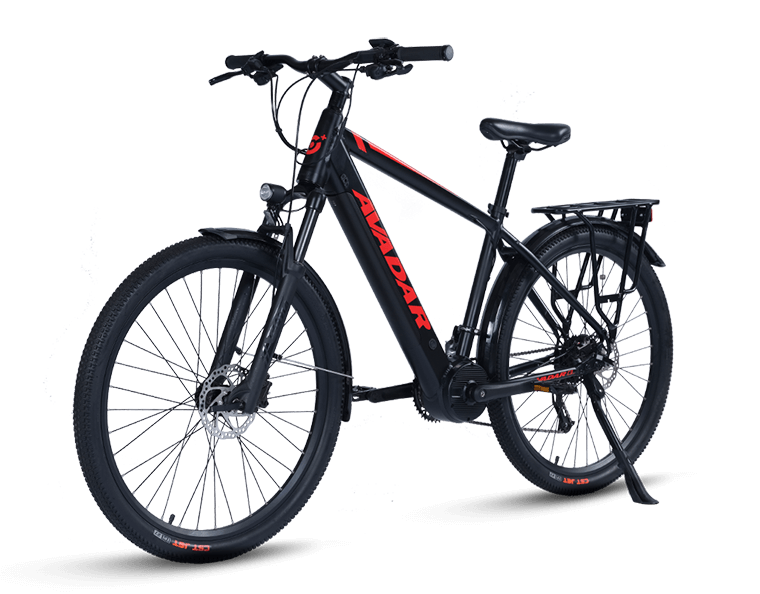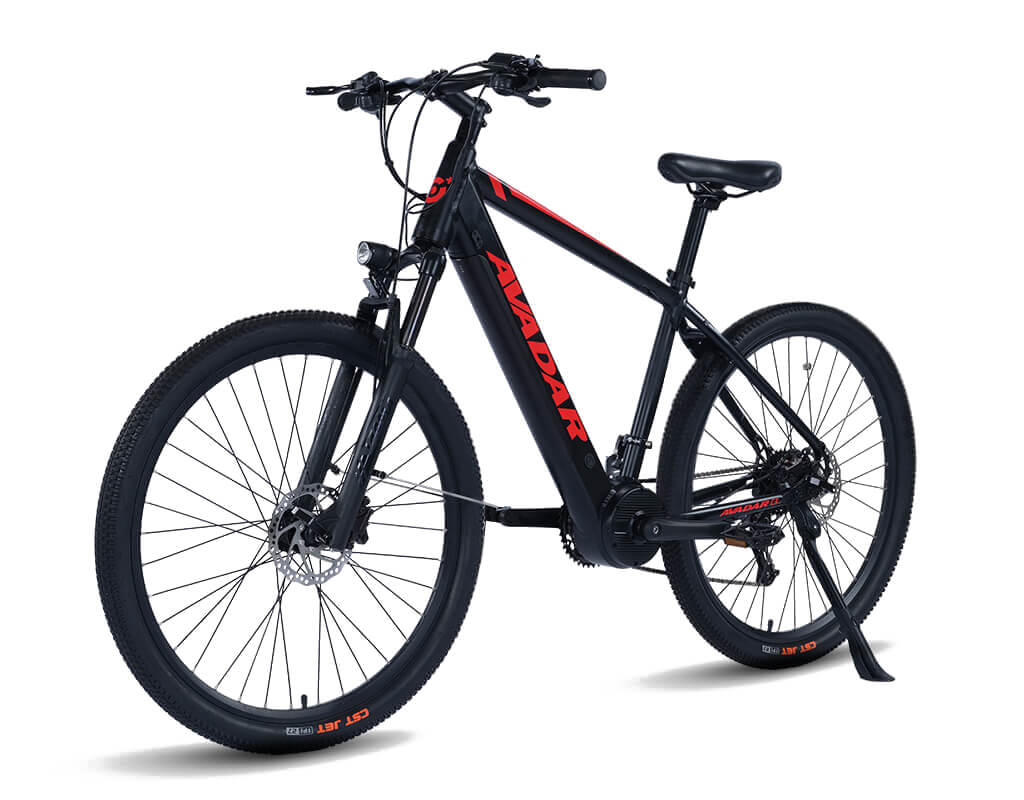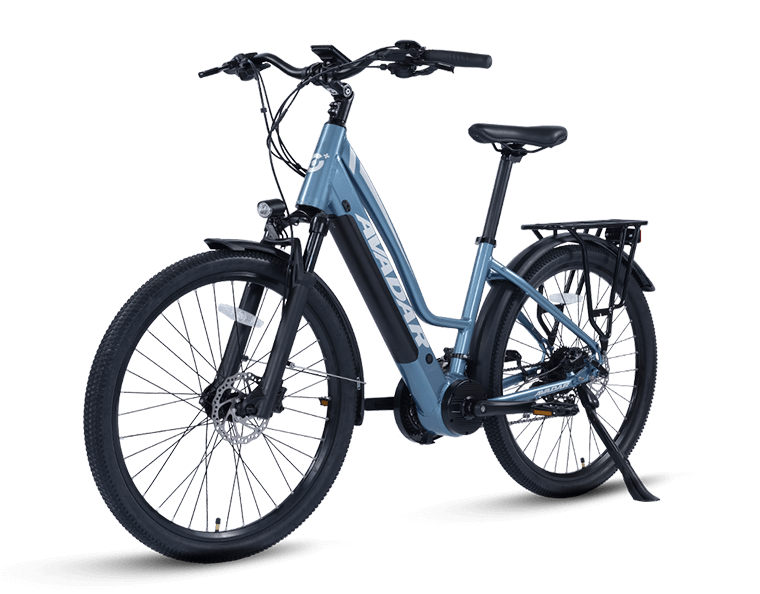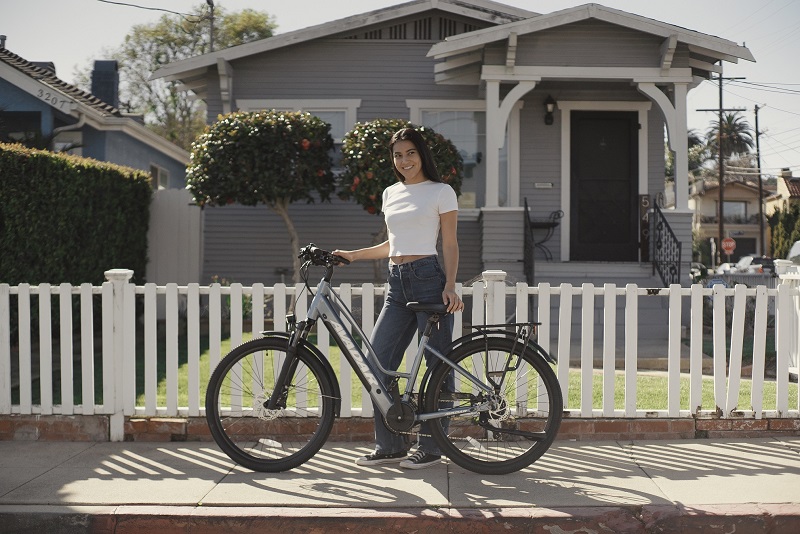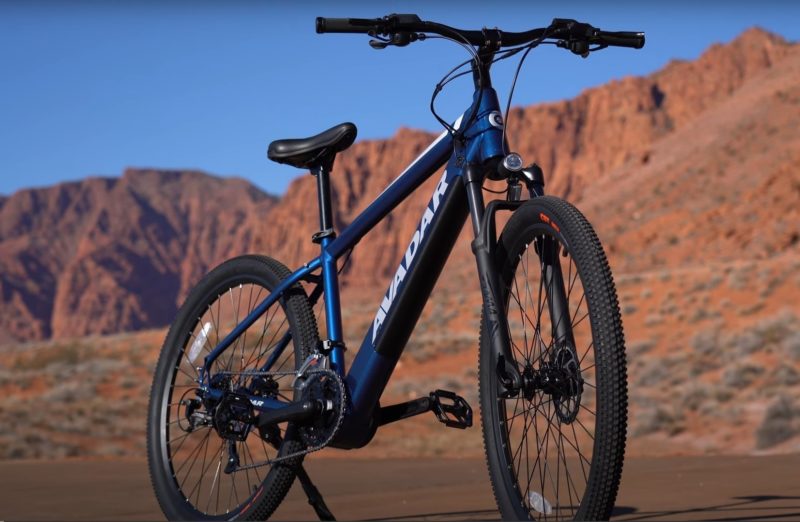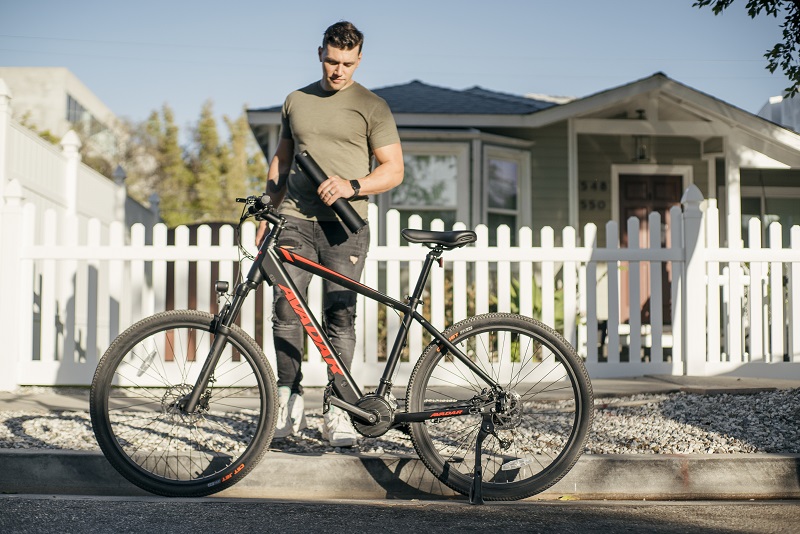
E-Bikes 101
Introduction: Your Electric Bike Buyer’s Guide
Do you wish you could commute to work on a bike, but don’t want to change from workout clothes to business casual the moment you arrive? Are you aching to get active and tackle steep hills but aren’t sure if your knees can handle the task? Do you want to find a more eco-friendly option for last-mile travel, but don’t have consistent access to e-scooters and e-bikes in your town?
Imagine cruising on a bike, powered by a motor, to work every morning without breaking a sweat, zipping up hills without wearing yourself out for the ride back home, or having fun and practical transportation alternative to reduce your carbon footprint. Electric bikes (e-bikes) make it possible for anyone in just about any shape, and just about every location, to enjoy the benefits of biking every day. The best part is that you’ll still get exercise, and you’ll have a blast! If you’ve heard of e-bikes, and are considering purchasing one for yourself, you probably have a ton of questions. You’ve come to the right place. In this guide, we’ll cover everything you need to know before shopping for an electric bike so that you can buy it with confidence. We’ll answer questions such as:
- What is the best electric bike to buy?
- What do I need to know about buying an electric bike?
- Do you have to pedal an electric bike?
- Can you get fit on an electric bike?
- What should I look for in an electric bike?
- What regulations should I know about?
Buying an electric bike is a big decision and an investment in your health and quality of life. Whether you’re a mountain biking expert or a beginner biker looking to commute or simply cruise some scenic trails, there’s an e-bike for you. Biking e-style can help you reach health goals, enjoy the recreational aspect of biking, and rely less heavily on cars if you choose. Ready to join millions in a biking revolution? We’re here to help you get started. Read this electric bike buyer’s guide or contact us at Avadar Bikes, and we’ll be thrilled to answer your questions and provide tips.
CHAPTER 1 - How Does An Electric Bike Work?
Electric bikes are becoming more popular as a transportation and recreation option, and they are currently the fastest-growing type of bicycle on the market. For example, e-bike sales totaled over $77 million in 2017 – up 91% from 2016. People across the country are switching out cars for e-bikes to zoom past traffic or have a completely new biking experience. E-bikes are booming, and we can’t wait to show you why. But, first thing’s first — you need to consider if an e-bike is exactly what you need.
In this chapter, we’ll cover the basics to help you decide if an e-bike is right for you and your lifestyle. If you’re excited to browse bikes now, check out our selection of e-bikes for beginners or seasoned e-bike enthusiasts.
What Is An Electric Bike?
If you’ve never seen an e-bike before, it may be hard to imagine exactly what one looks like or how it’s different from a regular bike.
E-bikes are like traditional bikes except they feature a compact electric motor to provide a power boost for climbing hills or traveling long distances. E-bikes are not the same as mopeds or motorcycles, are not loud, and don’t give off emissions.
If you have a particular taste in bikes or need a bike for a specific type of ride, you can be sure there’s an e-bike for you. E-bikes come in a range of shapes and sizes to suit different needs, whether you need an efficient e-bike for the morning commute or an extreme performer for rugged terrain.
Even though e-bikes are recently increasing in popularity, they aren’t something new. Electric bike prototypes date back to the late 19th century. This means that around the same time Karl Benz patented the first commercially available car, other inventors were working on improving the speed and power of bicycles. One inventor in particular — Ogden Bolton — filed a patent in 1895 for what may have been the world’s first electric bike. Thanks to innovators like Bolton, e-bikes are now available to all.
How Do Electric Bikes Work?
E-bikes work in the same way as traditional bikes as far as pedaling goes, but unlike traditional bikes, they feature a battery and a motor. The battery stores the power to drive the motor. The motor is compact and built into the hub of the back or front wheel, or mounted in the center of the bike. The motor is the component that spins the wheels.
Besides battery and motor, another important part of an e-bike is the speed sensor or torque sensor. A speed sensor, also known as a cadence sensor, automatically tells the motor to start once you start moving. A torque sensor, on the other hand, provides assistance to match your power, whether you’re going slow or fast. With a torque sensor, the harder you pedal, the greater the boost. Basically, a speed or cadence sensor detects if you’re pedaling, and a torque sensor measures how hard you’re pedaling.
Do You Still Have To Pedal An Electric Bike?
Part of what makes an e-bike so much fun and beneficial to your health is you can pedal whenever you wish — it’s completely up to you. The battery and motor provide a boost to help you bike up hills, over rough terrain, or cover long distances, so you can still bike and get exercise without overworking yourself. So, with an e-bike, you’re still biking, but you’re enjoying a faster, less stressful biking experience than you would with a traditional bike. If you decide you need to take a break, you can opt for throttle-only riding which doesn’t require pedaling, and enjoy the breeze while you speed down your favorite trail.
Overall, you have great flexibility with an e-bike. If you want the challenge of trekking uphill as you would with a traditional bike, you can turn the power off an e-bike, and switch it back on whenever you want. If you’re not in the mood for hill climbing, your e-bike will be ready to assist you.
Some e-bikes provide different levels of pedal assist to suit your needs. For example, Avadar Bikes offers ECO mode, which provides less power and helps the rider save more of the battery charge. A higher pedal assist level, like level 3, provides greater power to help you cruise up to 20 mph. The different power levels can be used to help you adhere to the local e-bike speed laws.
How Much Does An Electric Bike Cost?
The cost of an electric bike varies and depends on the riding you plan to do, and how often you plan to use your bike. If you intend to replace your car with an electric bike and commute to work, it’s worth getting an e-bike with more premium features and a larger battery for an enhanced riding range. If you plan on using your e-bike mostly for laid-back recreation, you might feel comfortable finding something that’s easier on your budget.
To give you an idea of what to expect, the average cost for an electric bike ranges between $2,000 and $3,000. Avadar electric bikes range from $1,980 to $2,380. Our practical C3 is great for beginners and costs $1,980.
No matter which model you choose, an e-bike is much less expensive than the cost to purchase and maintain a new car and can be an extremely economical choice if you plan on using your bike for regular transportation. The average cost of a car is $36,590, not to mention the added costs of regular maintenance, registration, and insurance, according to analysts at Kelley Blue Book. Whether you choose a higher-end bike or a more practical e-bike, you’ll still save big on costs compared to a car.
Is An Electric Bike Worth It?
Electric bikes typically cost more than traditional bikes, but they offer a way for anyone to bike wherever they need to go. With an electric bike, you’ll save money on gas, car maintenance, and car insurance as well as contribute to your health, so it’s what it’s worth to you.
Should I Buy an Electric Bike?
E-bikes are an excellent option to empower people who struggle to bike up hills, desire to ride for longer distances, are dealing with various physical limitations, or who would otherwise benefit greatly from a little boost.
They also make great alternatives to a car for those who want to avoid commuter traffic and enjoy a healthy ride to start their day right, while reaping the benefits of biking. E-bikes are incredibly fun and pretty much guaranteed to put a huge smile on your face!
Whether or not you should buy an e-bike is ultimately up to you. If biking is something you enjoy or if you’re interested in a fun way to improve your health and the environment, we say it’s certainly worth considering.
If you have more questions or want to speak with one of our team members, contact us today. We’ll be happy to share our knowledge with you, so you know exactly what to expect when you ride an e-bike for the first time.
CHAPTER 2 - What Will You Be Using Your Bike For?
One of the greatest factors you’ll need to consider when choosing an e-bike is what you’ll be using the bike for. Do you want to get fit, or is your goal to become less reliant on a car to get around – or both? In this chapter, we’ll answer your questions about e-bike uses and the benefits of riding an e-bike. If you’re still not sure if an e-bike is right for you, contact our team, and we’ll be happy to answer your questions.
Using An Electric Bike To Get Fit
E-bikes get riders where they need to go faster than traditional bikes, increase convenience and decrease physical fatigue. Plus, riding an e-bike is just plain fun! You can still pedal an e-bike, so that means you still get exercise and can improve your health. E-bikes simply assist you as you bike, but they don’t take over completely, and you can always pedal faster or turn the power off when you want to increase your heart rate.
More people want to bike, and e-bikes eliminate many of the common complaints people have about riding traditional bikes. According to a PeopleForBikes survey, half of the American adults want to ride bikes more often. Many people don’t ride bikes as much as they’d like to because they don’t have access to biking infrastructure. Another reason people avoid biking is comfort. People don’t want to arrive at work sweaty and tired, but e-bikes can help workers comfortably commute and get fit at the same time. E-bikes remove other obstacles that have prevented people from biking in the past, such as helping riders go longer and faster without putting extra stress on their joints.
Riding an e-bike is a great way to get started on a fitness plan. Most of all, using an electric bike motivates people to get fit. For example, according to a National Institute for Transportation and Communities (NITC) survey, out of 6.6% of adults who did not traditionally ride as an adult, almost 94% ride weekly or daily with an e-bike.
Even if you regularly ride bikes or are in excellent shape, you’ll ride longer with an e-bike and reap the health benefits. The majority of all respondents in the NITC survey, including adults who regularly rode bikes before purchasing an e-bike, ride more than they did with a standard bike because an e-bike is fun. Also, fit individuals can ride as they recover from the prior day’s workout. Use your e-bike as a means of transportation, and combine your power with the bike’s power, and you’re bound to see results.
Is Riding An Electric Bike Good Exercise?
Although an e-bike provides some assistance, regularly riding an e-bike provides an effective workout, especially for those who are otherwise sedentary.
A study published in the International Journal of Behavioral Nutrition and Physical Activity found evidence that e-cycling provides physical activity of at least moderate intensity, which is lower than conventional cycling but higher than walking.
A University of Colorado study found that e-bike riders experienced improved cardiovascular health after just a month of riding 40 minutes a day, three days a week. Therefore, e-bikes can improve cardiorespiratory fitness.
E-bikes provide a pleasurable way to exercise too, so riders look forward to getting outside and going for a ride. Motivation is key to sticking to an exercise routine. With an e-bike, you can easily replace driving with cycling, and fit in exercise throughout the day where you wouldn’t have exercised in the past.
Ultimately, you control your bike workout and can adjust assist levels to increase or decrease intensity to help you reach specific goals.
Using An Electric Bike To Commute
According to the NITC survey, one of the top reasons people buy e-bikes is to replace car trips. There are tons of benefits to commuting to work by e-bikes, such as saving money on car-related expenses, improving health, avoiding traffic, decreasing stress, avoiding parking hassles, and decreasing emissions.
Imagine the beauty and freedom of whooshing past motorists stuck in the morning jam, and being able to find a parking space the moment you arrive. And, if you’re not in the mood to hit the gym after a long day of work, there’s no need to feel like you sabotage your health. When you use an e-bike to commute to and from work, you can relax at the end of the day knowing you already did your health a favor — no gym membership required.
If you already commute to work by bike, switching to an e-bike will get you there faster, and you’ll arrive cool, collected, and ready to let your talents shine.
What Is The Best Electric Bike For Commuting?
The best e-bike for commuting depends on your needs.
To choose the best e-bike for your commute, consider the following factors:
- The length of your commute: The length of your commute will help you determine your comfort, speed, and battery range requirements. For example, if your workplace is only 3 miles from where you live, you can be a lot more flexible with the type of e-bike you choose because you don’t have to go very far. On the other hand, if you need to ride 9 miles to work every day, you’ll want something that’s designed for speed, comfort, and efficiency. Considerana Avadar 3 electric bike with a 52-volt (V) battery because this type of e-bike will go up to 28 mph, with a 40-plus mile riding range, and will help you get to work on time without any anxiety about running out of battery charge.
- The climate: What is the weather typically like where you live and work? Do you see a lot of precipitation where you live? If it rains a lot in your city, for example, you may want to choose a bike with wider tires rather than a typical commuter bike with large narrow tires. Make sure to consider how your e-bike will handle the weather where you live.
- Brake requirements: Will you need to do some heavy braking during your commute, or do you plan on cruising quiet back streets to get to work? If you need stopping power, precise braking, and brakes that perform well in wet weather, aim to choose a commuter e-bike with a quality hydraulic brake system.
- Topography: Consider the land features of your commute, and what you’ll need to bike through every day. If you live in a hilly area, for example, and want a basic e-bike that’ll reduce your effort as you go up hills, you should be fine with a Class 1 bike.
- Battery range requirements: Consider how many miles you’ll be traveling to and from work to choose an e-bike with the right range — or how far you can ride on one battery charge.
Lastly, consider if you want your e-bike to include space for a laptop, bag, or groceries. If so, look for an e-bike that comes equipped with a rack for additional storage capacity.
How Much Faster Is An Electric Bike?
The average cycling speed on a traditional bike for city riding is 11 to 12 mph. With an e-bike, you can go almost twice as fast with less effort because you can hit 20 or 28 mph before the pedal assists stops.
What Are The Benefits Of Riding An Electric Bike?
There are tons of reasons e-bikes are growing in popularity, and will likely continue to replace cars and traditional bikes. Here are some of the benefits of being an e-bike owner and reasons to feel good about enjoying your new ride:
- Greater control and cycling power: With an e-bike, you don’t give up any of the control you had with a traditional bike, but you do increase your power. You get to choose when or when not to use the pedal assist or throttle. You get to go up hills with an extra boost and without exhaustion. E-bikes put you in complete control of your biking experience.
- Time-saving speed: E-bikes provide the boost you need when you’re running short on time or want to experience more of a rush.
- A more enjoyable ride: Long rides can be rough even for the fittest individuals. An e-bike reduces the fatigue resulting from riding harder and longer and lets you make the most of your bike ride.
- Can increase fitness: E-bike owners look forward to riding and are more likely to bike and get the exercise they need. Whether you need to get or stay fit, an e-bike is a fun way to stay on track.
- Can ride in hilly areas: Hilly terrain does not need to keep you from biking when you own an e-bike. As an e-bike owner, you can zip up and down hills and still enjoy the physical and mental benefits of biking.
- Can bike without breaking a sweat: Going to work, a job interview, or an important meeting? With an e-bike, there’s no need to pack an extra set of clothes. The pedal assist will allow you to reach your destination on time without breaking a sweat.
- Save money on car expenses: Cars and car-related costs are financially draining. With an e-bike, you can take a break from the headache of maintaining a car and save money for other things you want to enjoy in life.
- Reduce your carbon footprint: The typical vehicle contributes an estimated 6 to 9 tons of greenhouse gases to the atmosphere each year. One way to drastically reduce your carbon footprint is to bike more often. Riding an e-bike, which does not emit any gases, is a fun and easy way to reduce your carbon footprint.
- Skip rush hour traffic: Have you considered quitting your job just to avoid rush hour traffic? Before you call it quits and move somewhere else, try commuting to work on an e-bike and get ready to kiss rush hour traffic goodbye.
- Makes biking accessible to those who couldn’t bike before: If certain medical conditions have prevented you from biking in the past, consider an e-bike to reduce the stress traditional biking puts on the body. E-bikes make biking possible for individuals with joint issues or who need to ease into a fitness plan.
- There are e-bikes available to meet your needs: E-bikes are available in many shapes and forms, just like traditional bikes. So, if you think all e-bikes are designed just for experienced cyclists, think again. Just reach out to us, and we’ll help you find what you need.
- They’re quiet: Are you envisioning a loud bike zipping around a quiet neighborhood, waking up the neighbors? E-bikes are not to be confused with motorcycles and sports cars, even though they’re fun to ride at full speed. E-bikes are quiet, and won’t disturb the peace of your community or your blissful ride.
CHAPTER 3 - Where Will You Be Riding?
Another factor to consider when selecting an e-bike is where you’ll be riding. Do you plan to mostly cruise country roads, zoom down urban lanes or go off-roading in the mountains?
In this chapter, we’ll explore the differences between e-bikes for on and off the road. We’ll also look at e-bike regulations to help you prepare for a safe ride. If you’re not sure which bike suits you, contact us at Avadar Bikes and we’ll help you find the best e-bike for your terrain.
Electric Bike Regulations
E-bikes are regulated by the Consumer Product Safety Commission for the sake of product safety. This means that the federal government only regulates the condition of an e-bike for sale, and not how it’s used. Federal law defines an e-bike as a low-speed electric bicycle with fully operable pedals and an electric motor of fewer than 750 watts, and which does not go faster than 20 mph when powered only by a motor. Federal law does not specify the max speed for traveling using a combination of human and motor power.
To know the e-bike laws that apply to you, you have to check with your state. State traffic laws vary and determine how e-bikes can be used within the state. The majority of states define electric bikes in their traffic laws, but some states do not. Also, some states have specific laws that apply only to e-bikes. For example, some states require a license to operate an e-bike. Other states apply the same laws to e-bikes as traditional bikes. A good place to learn about the e-bike laws in your state is to click on your state at Peopleforbikes.org.
Can You Ride An Electric Bike On The Sidewalk?
Like e-bike laws in general, bike sidewalk laws also vary by state and local governments. For example, New York does not have a statewide law prohibiting sidewalk bike riding, but a person cannot ride a bike on a sidewalk in New York City unless permitted by a sign. To look up your state laws regarding sidewalk riding, check out your state on Bikeleague.org.
What Age Can You Ride An Electric Bike?
Age restrictions also vary by state. For example, in California and Utah, an individual under the age of 16 may not operate a Class 3 electric bike. Arizona, Idaho, and Wyoming have no age restrictions to ride any class of e-bike.
CHAPTER 4 - How Far Will You Be Riding
You’ll need to know how long you plan to ride before choosing an e-bike. Will you be biking a short commute, or do you often like to bike miles upon miles of trails? Knowing what range you need will help you select the right battery. You’ll also know what to expect so you can plan your bike trips accordingly.
In this chapter, we’ll cover everything you need to know about e-bike batteries so you can hit the road worry-free and well prepared for the ultimate ride.
Electric Bike Battery Types
The battery is an important part of what makes an e-bike so enjoyable.
With a fully charged battery, you can cruise with the wind care-free. When the battery loses its charge, you can still pedal, but you’ll miss out on the e-bike fun.
Here are the different types of e-bike batteries:
- Lead-acid batteries: Lead-acid batteries are low-cost and easy to recycle, but are heavy and do not last very long. They are similar to the batteries used in cars.
- Nickel-cadmium batteries: Nickel-cadmium batteries last longer than lead-acid batteries but are difficult to recycle.
- Nickel-metal hydride batteries: Nickel-metal hydride batteries last longer than nickel-cadmium batteries and are easier to recycle, but generally offer the same performance.
- Lithium-ion batteries: Lithium-ion batteries last longer than the other batteries and generate more power. These types of batteries use the same technology as cell phone batteries.
Which Battery Is Best For An Electric Bike?
In general, the best type of battery is a form of lithium-ion battery. They are smaller and last longer than lead-acid batteries.
When considering batteries as you shop for an e-bike, consider watt-hours (Wh) which measure battery output and life. The higher Wh, the bigger the range. Aim to choose a bike that offers a range long enough to suit the length of your ride with the power level you need. Lastly, consider how long it takes to recharge the battery and how that fits into your e-bike goals.
How Long Does the Battery Charge Last?
How long a battery lasts depends on several different factors, including the battery power and the level of assistance you use. Any pedaling decreases battery to use and extends your range. Generally speaking, you can expect anywhere from a 25- to 70-mile ride on a single charge.
For example, through our range test, we found that on the bike with level 3 pedal assist, the range increased to 77 miles at 10 mph.
The overall life span of a battery depends on the type of battery. Lead-acid batteries typically last 200 to 300 charge cycles, while lithium batteries last from 500 to 1,000 charge cycles.
